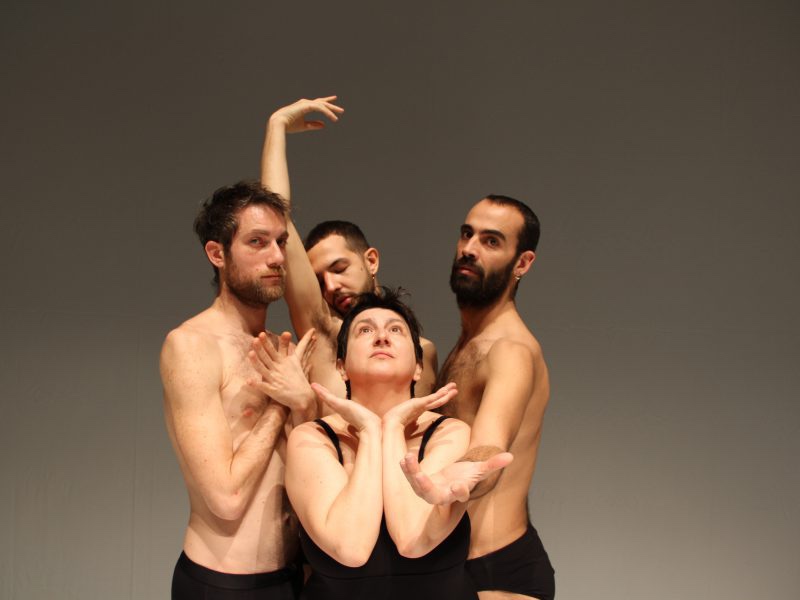Words by Giordana Patumi.
On Thursday, December 30th at Teatro Morlacchi in Perugia a wide laugh filled the seats of the theatres while on stage there was ‘Graces’ by Silvia Gribaudi.
Silvia Gribaudi, an artist from Turin, is active in the performing arts and in the conduction of artistic-social workshops focused on the enhancement of the uniqueness of each individual. Her choreographic language comes from the encounter between dance and irony and crosses the performing art, dance and theatre, focusing on the body and the relationship with the public. Her poetics revolves around the constant search for comparison and inclusion with the social and cultural fabric in which the performances are developed.
“We will not start from a preconceived idea of Beauty: we will review the things that human beings have considered as beautiful.” This is the popular yearning of Umberto Eco highlighted in the introduction to the History of Beauty (Bompiani, 2012), a philological and narrative journey on the idea of beauty over the centuries, on what is considered as such regardless of the desire: not everything that is beautiful is, the author will show, desirable.
But how do we reflect on beauty today? Silvia Gribaudi affirms: “During my reflection on beauty I met Andrea Rampazzo, Siro Guglielmi and Matteo Marchesi. All of us met in Bassano del Grappa where some sketches by Antonio Canova are preserved. Hence the choice of the theme of the Three Graces gave us the inspiration to start working on Graces.”
In line with the neoclassical thought of Johann Joachim Winckelmann, Canova’s sculptural group would depict the serenading predisposition of the three daughters of Zeus: Aglaia, Euphrosyne and Thalia, representing splendour, joy, and prosperity.

From a scenic point of view, we see, on an empty and white stage, three male figures (the dancers Rampazzo, Marchesi, and Giacomo Citton — substitute Guglielmi) together with Gribaudi in pants and black socks. Simplicity and essentiality are inscribed in scores of movements in which the code of classical dance and the code of beauty are dialectically placed in parallel and both deconstructed.
The Graces of Antonio Canova are not really identical to each other: the positions are different, and they also accentuate different parts of the body. The sculpture was looking for an absolute and universal beauty, an ideal connection between Man and Nature. In some way, the beauty of the Graces is therefore abstract. The parameters of beauty change according to the era. Even in dance at the beginning of the 20th century, the dancers were not very thin, there were many more curves, the knees were not overstretched. Then, with time, the beautiful line was defined as hypertension, of the knee and of the body in general. A dancer must have certain proportions, but these change over time.
On Gribaudi’s ‘Graces’ on stage, there are three magnificent performers who, through their movements, allow Gribaudi herself to experiment, to act as a mediator between the audience and the stage.
Beyond the irony that distinguishes Gribaudi’s language, the real short-circuit is the contemporary wriggle implied in making the idea of beauty coincide with its phenomenon both choreographically and dramaturgically, a performance that desacralised both concepts.
The gestures are hybridised both by elements proper to competitive practice and by the stylistic elements of classical dance, made freely accessible in a dialogue with the spectators who, through the features of Gribaudi, rediscover a liberated dance and the public domain of this art form.
The empirical matrix can be traced in the structure of the performance itself. The movement scores open up to a dialogue in which Gribaudi comments on the scenic actions by asking the spectators questions aimed both to support the performance as well to leave us with a sense of self-reflection to carry home afterwards.
Beauty is thus made experienceable, it is not contemplated as something a priori has given but it is used as a phenomenal object, to be modified. The use of models and the participation in games and involvement within which they are inserted makes their conceptual value accessible, releasing their entertainment character. Here then that beauty becomes today something extremely amusing and common.
I came out of the theatre reinvigorated and joyfully filled with the condition, I think, Greeks must have felt during the years of wars after watching plays and tragedies at the Theatre of Epidaurus. Now our wars are much different today but nevertheless heavy on our spirits. Awarded Italian Production of the Year 2019, ‘Graces’ made us laugh first and then, leaving the theatre with a deeply personal question ‘what is beautiful and what does that mean to us?’ I’m sure many of us will reflect a lot after watching the cathartic work made by Silvia Gribaudi.
Header image: Matteo Maffesanti.
